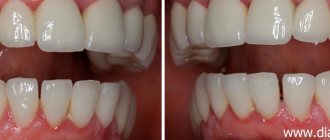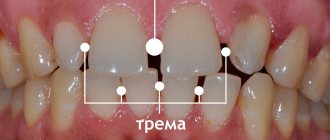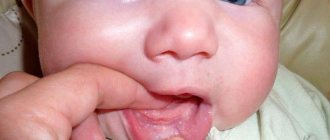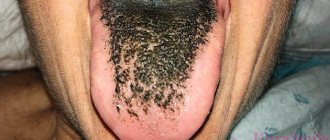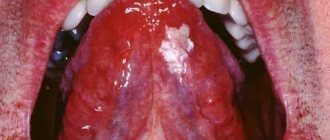A tumor of the upper lip in a child may appear for no apparent reason, that is, it was not preceded by a blow, and the presence of an abscess (boil) is not visually determined. The fact is that the mucous membranes in the oral cavity are characterized by increased sensitivity, especially in children (the immune system is not fully formed), which means that swelling can be caused by a variety of factors. A swollen upper lip in a child is a reason to visit a doctor, and first of all you need to see a dentist, since there are diseases of the oral cavity in which the first symptom will be severe swelling of the mucous membrane and, as a consequence, the phenomenon in question.
Symptoms of gum inflammation
According to statistics, more than 70% of people have experienced inflammation of the gums between their front teeth at least once in their lives. The main signs of the problem include:
- redness of the gingival papilla,
- swelling of soft tissues,
- bleeding gums,
- bad breath,
- accumulation of pus in the interdental space,
- discomfort when brushing teeth and eating.
If you notice any of these signs, you should consult your doctor. These symptoms can indicate either injury to the gums from hard food or bones, or the development of serious diseases.
Treatment of herpes in the mouth
Can herpes be in the mouth?
Maybe! Herpes in the mouth requires the same responsible approach and competent treatment as other diseases of the oral cavity. Despite the fact that the infection is often mild and goes away naturally, there are still risks of serious complications, and the possibility of infecting other people remains. Many factors influence the degree of development of the pathology and the presence of possible dangers for the patient. Complete diagnosis and comprehensive treatment can completely stop the manifestations of the infection, although complete elimination of the virus is considered impossible. Herpes, a viral disease known to many as a “cold sore,” is often perceived as a minor problem that does not require treatment. It is characterized by the appearance of a moderately painful blistering rash, but not many people know that this disease is not limited to appearing only on the lips , but can also develop on the oral mucosa . The disease is often accompanied by weakness, general malaise and severe itching, and in some cases can cause complications. During the active phase of the virus, a patient can easily infect others with it through household items, close contact or by airborne droplets.
Possible reasons
In most cases, the gums become inflamed due to poor oral hygiene. Plaque accumulates on the teeth, which is a favorable environment for the proliferation of microbes. Soft deposits compact and transform into tartar, which is located along the edges of the gums. Inflammation between the front teeth can also be associated with smoking, mechanical damage to the gingival papilla, a burn to the oral cavity, or a lack of vitamins and minerals in the body.
This symptom is also characteristic of the clinical picture of the following diseases:
- gingivitis – inflammation of the mucous membrane due to the accumulation of plaque, accompanied by redness and swelling of the gums;
- periodontitis – develops with advanced gingivitis, leads to the formation of periodontal pockets, loosening of teeth and their loss;
- papillitis is inflammation of the interdental papilla; provoking factors include caries, thermal and mechanical effects, allergic reactions, endocrine diseases.
Diagnostics will help to establish the exact cause of the problem: visual and instrumental examinations, radiography.
Indications for labial frenuloplasty
Normally, the frenulum does not interfere with a person in any way, but in some cases it can cause significant discomfort. Due to certain physiological characteristics, it can interfere with normal speech, negatively affect teeth and cause malocclusion. In such cases, surgery is necessary.
If there are abnormalities in the attachment of the frenulum to the upper or lower lip, surgical plastic surgery is indicated. Indications for surgery may be:
- formation of a diastema (gap between the front teeth);
- disorders of chewing functions;
- inflammation of the gums;
- periodontal diseases;
- dysfunction of sucking in infants;
- speech defects in children, etc.
Upper lip frenuloplasty is also performed for hygienic reasons. A wide frenulum leads to a systematic accumulation of deposits between the teeth. As a result, plaque forms on the surface of the incisors, and then tartar. All this can cause the development of caries and inflammation of soft tissues.
Another common complication that accompanies an incorrect frenulum is the development of tooth instability and increased sensitivity. A wide frenulum leads to exposure of the roots of the teeth, which significantly reduces overall immunity in the oral cavity. Bacteria and infections easily penetrate the gums, which leads to various periodontal diseases.
A short frenulum interferes with normal speech. The operation must be carried out for freer movement of the tongue and lips, without which the development of correct diction is impossible. The decision to correct the frenulum in this case is made by a speech therapist.
Indications for plastic surgery are determined by the following specialists:
- orthodontist;
- neonatologist;
- speech therapist,
- periodontist.
Plastic surgery to correct the frenulum of the upper lip should be performed in childhood. The most optimal age is 7-8 years (after complete eruption of the upper incisors). Advanced anomalies, such as an overly wide frenulum, can lead to serious consequences that can only be eliminated with long-term orthodontic treatment.
Treatment methods
Treatment of inflamed interdental papillae is aimed at eliminating increased sensitivity and pain. This may include:
- rinsing the mouth with antiseptic solutions and chamomile decoction,
- applications of anti-inflammatory gels and ointments,
- taking antibacterial drugs,
- professional teeth cleaning,
- coagulation of overgrown tissues.
The treatment regimen is chosen by the doctor taking into account the diagnosis, clinical picture, and individual characteristics of the patient’s oral cavity.
What to do if your child has a swollen upper lip
If parents know that the condition in question was caused by a blow or insect bite, or an allergy to an external irritant, then you should not consult a doctor. You can apply a cold compress to the area and give the baby one of the usual antihistamines - after 20–30 minutes the swelling will become much less.
But in the case of a tumor of unknown origin or the presence of other changes in the child’s health (weakness, complaints of pain and burning, increased general body temperature), you must immediately contact a pediatrician. The doctor will conduct an initial examination and find out the true cause of this condition. Only after this will he give a referral for examination by a dentist, if required.
In turn, the dentist will visually assess the condition of the oral cavity, make a diagnosis and make medication prescriptions. They can be very different:
- antibacterial drugs;
- antiviral agents;
- antiseptic solutions for irrigating the oral cavity and rinsing it;
- antifungal drugs.
If a child has a swollen upper lip, the doctor will tell you what to do in this situation. Self-medication in this case can cause deterioration of the condition and rapid spread of the inflammatory process. If the cause of the swelling is a purulent focus, then the lack of qualified assistance can lead to serious consequences: damage to the soft tissues and periosteum of the jaw, and general blood poisoning.
Plastic surgery of the frenulum of the tongue, upper and lower lips - features of the procedure
Defects of the frenulum of the tongue and lips: features and treatment methods
Frenules are mucous cords that are attached to the tongue, upper and lower lips.
Under normal conditions, they are not felt by humans in any way. But some patients experience pathologies of their development. Because of this, they feel discomfort, the cords are constantly injured, inflammation, bleeding and other problems occur. The situation can be corrected by plastic surgery of the tongue frenulum, which is performed in dental clinics. If you ignore the problem, it can lead to serious consequences:
- Incisor diastema (gap between teeth).
- Pronunciation problems.
- Periodontal inflammation, root exposure. There may be problems with bone tissue that lead to increased tooth mobility.
- Difficulty with chewing and swallowing food.
Also, due to problems with the frenulum, the child may develop an incorrect bite, and in particularly difficult cases, a violation of the formation of the jaws. Plastic surgery of the child's tongue frenulum will allow him to get rid of the pathology once and for all.
How to determine if there are problems
You can tell that a child has a short frenulum by the following signs:
- Newborn babies have problems sucking at the breast. The baby gets tired quickly, the procedure itself takes longer than usual. Many children give up breastfeeding early and switch to artificial nutrition.
- At 7–9 months, children develop an anomaly in the lower jaw. The hollow of the chin sinks, the tongue moves with difficulty.
- At 5–6 years old, a child cannot pronounce the sounds “r” and “l” normally.
- At the age of 8–9 years, the lower central teeth shift, and bite pathologies appear. Children with a short frenulum find it difficult to chew; it is constantly injured, there is inflammation on the gums, and the teeth become exposed and loose.
In most cases, frenulum cutting surgery is performed between the ages of 5 and 7 years. But some parents ignore the problem, due to which teenagers face various problems. Surgeries are also possible for adults. If you experience discomfort or difficulty, consult an experienced dentist.
Indications and contraindications
Before carrying out any actions, the dentist examines the small patient and decides on intervention or non-intervention. The operation is usually performed on children over 5 years of age. Newborns undergo plastic surgery only in cases where the frenulum seriously limits the mobility of the tongue.
The following are considered indications:
- A massive cord prevents the normal development of the lower jaw.
- The frenulum prevents the tongue from moving. The baby cannot pronounce sounds or chew normally.
- A pocket forms between the gum and lip, which is called a diastema.
- The baby’s bite begins to disturb (or there is simply a threat of such a situation occurring).
Adults sometimes undergo plastic surgery because the frenulum interferes with the placement of crowns or implants on the front of the jaw. Contraindications for surgery include:
- The patient has problems with blood clotting.
- Untreated caries or other dental diseases.
- The presence or acute phase of chronic diseases.
- Infectious diseases.
- The presence of inflammation or disease on the mucous membrane.
It is also not recommended to carry out intervention in the presence of tuberculosis, hepatitis, sexually transmitted diseases, etc.
How the correction is carried out
There are two ways to correct the situation:
- Classic method. A scalpel is used for cutting. The mucous membrane is dissected and then stitched in the required manner. The healing process takes 2–4 days.
- Laser correction. Instead of a scalpel, a laser beam is used. Due to the high temperature, the tissue immediately coagulates, so bleeding does not occur. Rehabilitation usually takes two days.
Modern dentists usually use lasers. It is safer and more practical. Thus, to correct the lip or tongue, classical anesthesia is not needed, the operation takes little time, and the risks of infection are minimized.
What to do after surgery
The wound after correction heals within 2–6 days, depending on the individual characteristics of the body. At this time, you need to be extremely careful not to damage the flesh or introduce an infection into it. It is recommended to rinse your mouth after every meal; in some cases, the doctor may prescribe antibiotics to the patient.
Follow these guidelines:
- For the first couple of weeks, it is recommended to avoid eating solid foods (meat, apples, nuts, etc.).
- You should not eat too hot, cold, spicy or sour foods, as well as drinks, including alcohol.
- Contact your dentist two to three days after surgery to monitor the healing process.
Sometimes the doctor may prescribe a course of restorative exercises. Be sure to go through it to get rid of the problem. Maintaining good hygiene is also important, but be careful not to damage the soft tissue when brushing.
If you want the operation to be as quick and painless as possible, then contact Crystal Dentistry. Qualified doctors work here and have all the equipment necessary for diagnosis and treatment. Call us, we work without breaks and weekends.
At what age is the procedure performed for children?
In children, pathologies of the lower lip frenulum can cause various negative medical and aesthetic consequences. Therefore, if a doctor finds a defect during a routine examination and recommends plastic surgery, it is better to take his advice.
Dentists believe that the best age for frenulum correction in children is from 5 to 8 years. It is during this period that temporary teeth are replaced with permanent ones, so it is important that the frenulum does not disrupt the correct development of the molar units.
If there are indications, plastic surgery of the lower lip frenulum can be performed in adolescents or adults. For infants, this operation is prescribed only if there are serious problems, for example, the inability to fully feed on breast milk.
Methods for fixing the problem
Correction of lip frenulum is carried out on an outpatient basis, under the influence of conduction or local infiltration anesthesia.
There are three ways:
1. Dissection of the frenulum (frenulotomy) – the frenulum is dissected with a transverse incision, which is pulled together and stitched in the longitudinal direction.
2. Excision of the frenulum (frenulectomy) - the frenulum is stretched using a clamp and then excised between the front teeth. The mucous membrane bordering the incision is peeled off, while the edges of the wound are brought closer to each other by bringing them together and stitching them together.
3. Frenuloplasty consists of moving the place of attachment of the frenulum: a median vertical incision is made, at both ends of which additional incisions are made at an acute angle. Triangular flaps peel off and counter movement occurs. They are stitched together horizontally.
